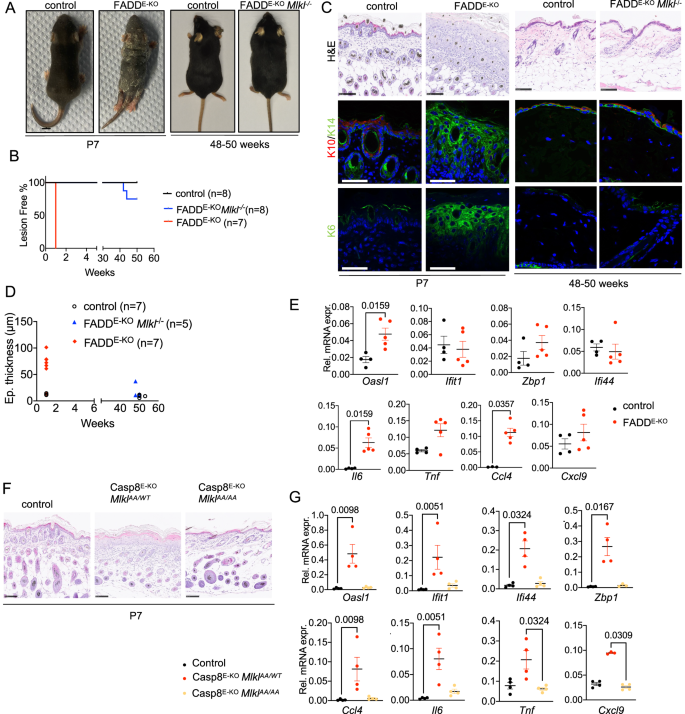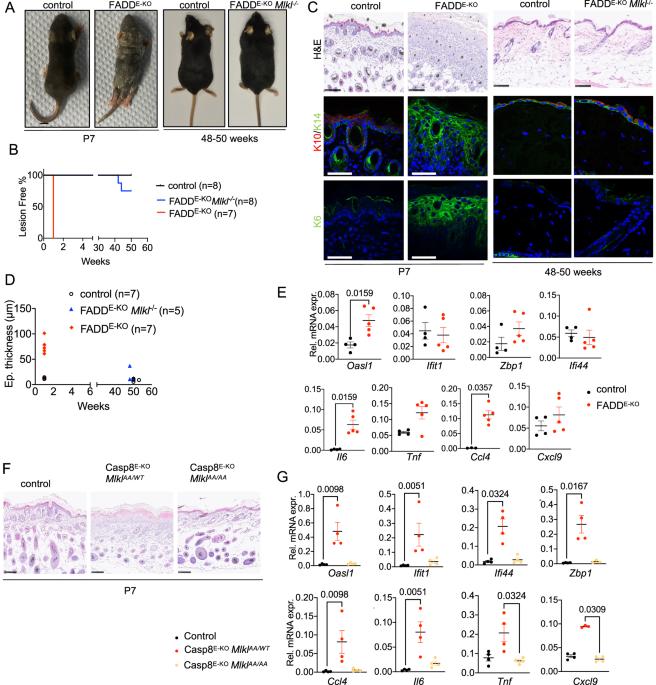ZBP1 通过诱导 RIPK3 介导的坏死和 RIPK1 激酶活性依赖性凋亡来引起炎症。
IF 13.7
1区 生物学
Q1 BIOCHEMISTRY & MOLECULAR BIOLOGY
引用次数: 0
摘要
Z-DNA 结合蛋白 1(ZBP1)在抗病毒免疫和调节炎症反应方面具有重要功能。然而,ZBP1 诱导炎症的机制,特别是 RIPK1 的作用和细胞死亡无关信号的贡献,仍然难以捉摸。在这里,我们发现 ZBP1 通过诱导角质形成细胞中 RIPK3 介导的坏死和 RIPK1-caspase-8 介导的凋亡来引起皮肤炎症。在表皮特异性消融 FADD 的小鼠体内,ZBP1 通过引发角质形成细胞坏死,诱导 TNFR1 依赖性皮肤炎症。此外,在小鼠表皮中转基因表达 C 端截短的组成型活性 ZBP1(ZBP1ca)会引起皮肤炎症,而这种炎症仅部分受到 RIPK3-MLKL 依赖性坏死的抑制,并完全被 MLKL 和 caspase-8 的联合缺乏所阻止。重要的是,ZBP1ca 通过依赖 RHIM 但不依赖激酶活性的 RIPK1 信号诱导 caspase-8 介导的皮肤炎症。此外,联合抑制细胞凋亡和坏死可以完全阻止 ZBP1ca 诱导的皮肤炎症细胞因子的产生,这表明 ZBP1 具有不依赖于细胞死亡的促炎功能。总之,这些结果表明,ZBP1 通过激活坏死和 RIPK1 激酶活性依赖性凋亡诱导炎症。本文章由计算机程序翻译,如有差异,请以英文原文为准。


ZBP1 causes inflammation by inducing RIPK3-mediated necroptosis and RIPK1 kinase activity-independent apoptosis
Z-DNA binding protein 1 (ZBP1) has important functions in anti-viral immunity and in the regulation of inflammatory responses. ZBP1 induces necroptosis by directly engaging and activating RIPK3, however, the mechanisms by which ZBP1 induces inflammation and in particular the role of RIPK1 and the contribution of cell death-independent signaling remain elusive. Here we show that ZBP1 causes skin inflammation by inducing RIPK3-mediated necroptosis and RIPK1-caspase-8-mediated apoptosis in keratinocytes. ZBP1 induced TNFR1-independent skin inflammation in mice with epidermis-specific ablation of FADD by triggering keratinocyte necroptosis. Moreover, transgenic expression of C-terminally truncated constitutively active ZBP1 (ZBP1ca) in mouse epidermis caused skin inflammation that was only partially inhibited by abrogation of RIPK3-MLKL-dependent necroptosis and fully prevented by combined deficiency in MLKL and caspase-8. Importantly, ZBP1ca induced caspase-8-mediated skin inflammation by RHIM-dependent but kinase activity-independent RIPK1 signaling. Furthermore, ZBP1ca-induced inflammatory cytokine production in the skin was completely prevented by combined inhibition of apoptosis and necroptosis arguing against a cell death-independent pro-inflammatory function of ZBP1. Collectively, these results showed that ZBP1 induces inflammation by activating necroptosis and RIPK1 kinase activity-independent apoptosis.
求助全文
通过发布文献求助,成功后即可免费获取论文全文。
去求助
来源期刊

Cell Death and Differentiation
生物-生化与分子生物学
CiteScore
24.70
自引率
1.60%
发文量
181
审稿时长
3 months
期刊介绍:
Mission, vision and values of Cell Death & Differentiation:
To devote itself to scientific excellence in the field of cell biology, molecular biology, and biochemistry of cell death and disease.
To provide a unified forum for scientists and clinical researchers
It is committed to the rapid publication of high quality original papers relating to these subjects, together with topical, usually solicited, reviews, meeting reports, editorial correspondence and occasional commentaries on controversial and scientifically informative issues.
 求助内容:
求助内容: 应助结果提醒方式:
应助结果提醒方式:


